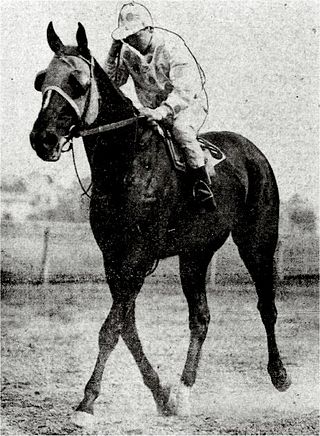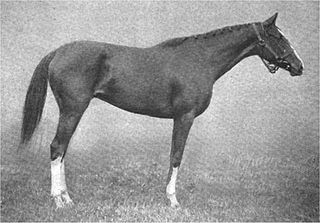Related Research Articles

The Belmont Stakes is an American Grade I stakes race for three-year-old Thoroughbreds run at Belmont Park in Elmont, New York. It is run over 1.5 miles. Colts and geldings carry a weight of 126 pounds (57 kg); fillies carry 121 pounds (55 kg). The race, nicknamed The Test of the Champion, The Test of Champions and The Run for the Carnations, is the traditional third and final leg of the Triple Crown. It is usually held on the first or second Saturday in June, five weeks after the Kentucky Derby and three weeks after the Preakness Stakes. The 1973 Belmont Stakes and Triple Crown winner Secretariat holds the track record of 2:24.
The Triple Tiara of Thoroughbred Racing, formerly known as the Filly Triple Crown, is a set of three horse races in the United States which is open to three-year-old fillies. Presently the only official Triple Tiara is the three race series in New York; they are: The Acorn Stakes, run at Belmont Park at a distance of 1 mile, The Coaching Club American Oaks, run at Saratoga Race Course at a distance of 1⅛ miles and The Alabama Stakes, also run at Saratoga at a distance of 1¼ miles.

Orlando was a British Thoroughbred racehorse best known for winning the Derby and as a Leading sire in Great Britain and Ireland.
The Matron Stakes is an American Thoroughbred horse race held annually during the fall season at Belmont Park, the New York Racing Association (NYRA) track in Elmont, Long Island, New York. It is open to two-year-old fillies and is the filly counterpart to the Belmont Futurity Stakes.
The Woodward Stakes is an American Grade I stakes race and is one of the premier races for older thoroughbred horses in the United States. It is named for prominent racehorse owner William Woodward.

War Emblem was a champion American Thoroughbred racehorse who won the 2002 Kentucky Derby and Preakness Stakes.

A.P. Indy was an American Thoroughbred racehorse who won the Belmont Stakes and Breeders' Cup Classic on his way to American Horse of the Year honors in 1992. His time in the Belmont Stakes tied Easy Goer for the second-fastest running in the history of the race, behind his damsire Secretariat.
A graded stakes race is a thoroughbred horse race in the United States that meets the criteria of the American Graded Stakes Committee of the Thoroughbred Owners and Breeders Association (TOBA). A specific grade level is then assigned to the race, based on statistical analysis of the quality of the field in previous years, provided the race meets the minimum purse criteria for the grade in question. In Canada, a similar grading system is maintained by the Jockey Club of Canada. Graded stakes races are similar to Group races in Europe but the grading is more dynamic in North America.

Beldame (1901–1924) was an American racehorse and broodmare.

Rags to Riches is a champion American Thoroughbred racehorse who won the 2007 Belmont Stakes, the first filly to win it in over a century.
Ruthless (1864–1876) was an American Thoroughbred filly and a National Museum of Racing and Hall of Fame-inducted racehorse. She is best known as the winner of the inaugural Belmont Stakes.
The Ruthless Stakes is an American open or non-Graded stakes race held yearly since 1974 at Aqueduct Racetrack in Queens, New York City. Run in January, it is a six furlong thoroughbred horse race for three-year-old fillies carrying a weight of 121 pounds (54.9 kg). The Ruthless currently offers a purse of $100,000.

Peter Pan (1904–1933) was an American Thoroughbred racehorse and sire, bred and raced by prominent horseman, James R. Keene. As winner of the Belmont Stakes, the Brooklyn Derby and the Brighton Handicap, he was later inducted into the National Museum of Racing and Hall of Fame. His progeny included many famous American racehorses, including several winners of the Kentucky Derby and the Preakness Stakes.

Tanya (1902–1929) was an American Thoroughbred racehorse bred and raised in Kentucky. She was bred by William Collins Whitney and foaled at his Brookdale Farm in Lincroft, New Jersey. Sired by the outstanding English stallion Meddler, she was out of the mare Handspun.

In the United States, the Triple Crown of Thoroughbred Racing, commonly known as the Triple Crown, is a series of horse races for three-year-old Thoroughbreds, consisting of the Kentucky Derby, Preakness Stakes, and Belmont Stakes. The three races were inaugurated in different years, the last being the Kentucky Derby in 1875. The Triple Crown Trophy, commissioned in 1950 but awarded to all previous winners as well as those after 1950, is awarded to a horse who wins all three races and is thereafter designated as a Triple Crown winner. The races are traditionally run in May and early June of each year, although global events have resulted in schedule adjustments, such as in 1945 and 2020.
Mar-Kell (1939–1966) was an American Champion Thoroughbred racehorse. Her dam was the 1934 American Champion Two-Year-Old Filly Nellie Flag, and her sire was the 1930 Epsom Derby winner Blenheim, who had been imported to the United States in 1937 by a syndicate that included Mar-Kell's breeder, Calumet Farm.
Spinaway was an American Thoroughbred filly for whom the Grade 1 Spinaway Stakes at Saratoga Race Course is named.
The 1885 Belmont Stakes was the 19th running of the Belmont Stakes, a race that would become the third leg of the U.S. Triple Crown series. Run on June 6, 1885, it was the 19th time the event was held at Jerome Park Racetrack in The Bronx, New York. The race drew six starters and was won easily by Tyrant who beat George L. Lorillard's runner-up St. Augustine by three lengths, with third place going to Preakness Stakes winner Tecumseh owned and trained by Charles Littlefield Sr. Heavily favored, Tyrant's winning time was 2:43 flat over a distance of 1½ miles on a dirt track which was rated as good. The Breeder and Sportsman report on the race stated that "Tyrant won the race in the most easy manner possible."
The Nursery Stakes/Handicap was an American Thoroughbred horse race run in New York State for the first time on October 1, 1866 at Jerome Park Racetrack. Following the closure of that track after New York City had announced its decision to build the Jerome Park Reservoir on the property, the race was taken over by the Morris Park Racecourse. When that track closed after the 1904 running, it was transferred to Belmont Park where it would remain until its final running on September 27, 1938.
References
- ↑ 1867 Belmont Stakes chart
- ↑ Grimes, William. "Belmont Awaits Its Annual Return to Glory". The New York Times . June 9, 2011.
- ↑ Johnson, J. Keeler. "Ruthless: The First Belmont Stakes Winner". America's Best Racing. April 24, 2017.